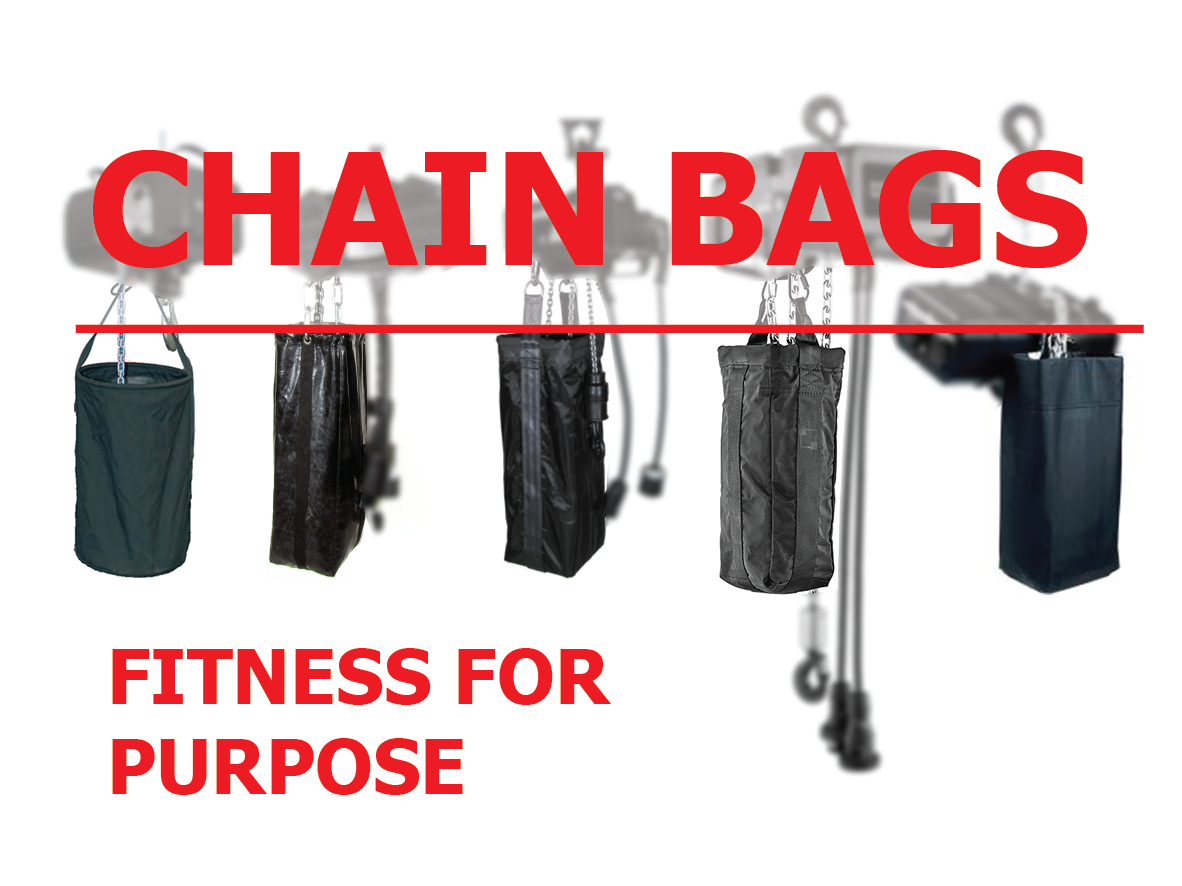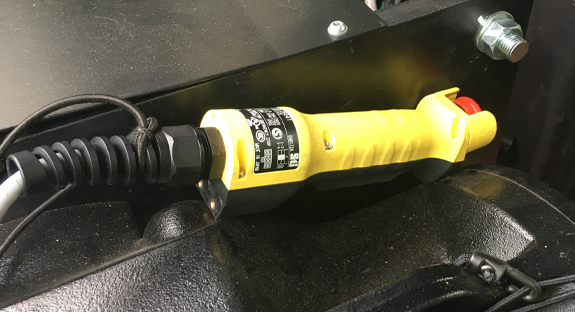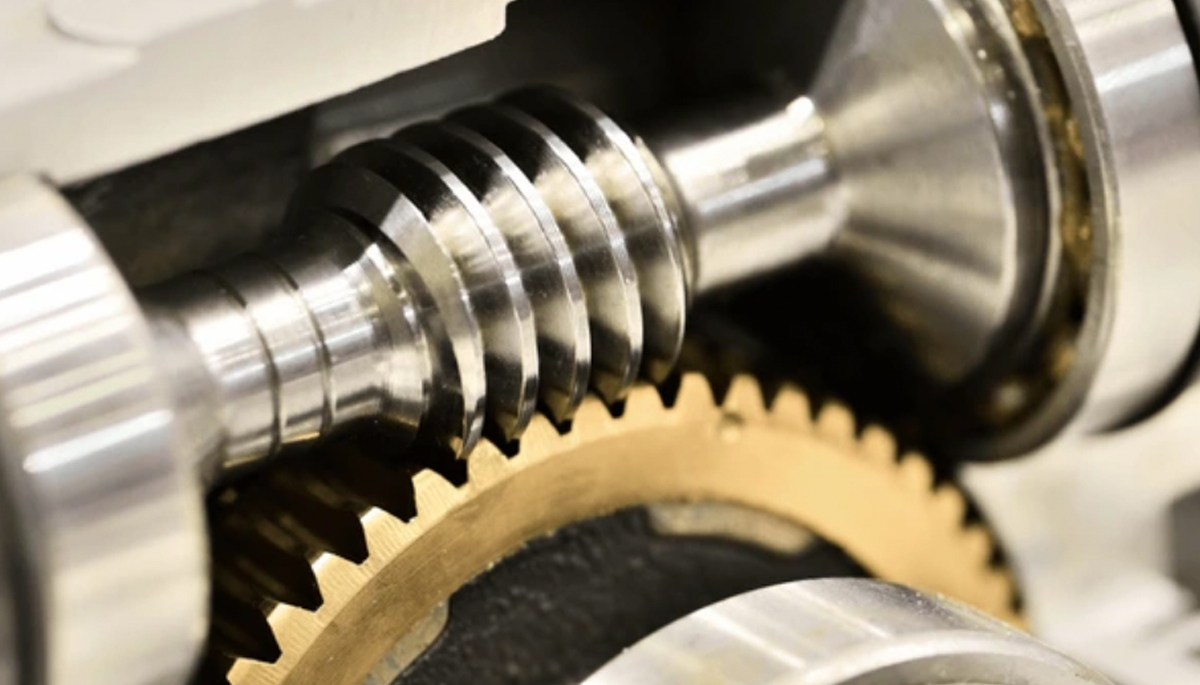Introduction
Manual and Electric chain hoists used in the entertainment industry, are normally put into service fitted with a device with the intended use to allow the storage of the load chain: a chain bag (or chain container).
Chain bags for hand chain hoists are often designed as a “bucket”, large enough to contain the load chain, hand chain and sometimes the hand block as well.
Chain bags for electric chain hoists can have a bucket or rectangular shape, with one or more attachment points, normally designed to be attached to the body of the hoist in order to allow the unloaded chain to run easily in and out it.
There is a large variety of chain containers available in the market, with different shapes and hardware connection solutions; sometimes chain hoist manufacturers place onto the market chain hoists fitted with a chain bag, other times they do not supply the chain container which is then purchased elsewhere and installed by the machinery owner.
It has been estimated that there are at least half a million electric chain hoists currently in use for installations within the event industry – concert touring in particular – and there have been some reported accidents1 related to the failure of chain bags with consequent release of the stored load chain.
During the years, many people asked to Blumano when a chain bag can be considered adequate, fitting the purpose of its function and consequently when we can it be considered safe.
Let’s see if we can throw a bit of light on it.
Legal framework: Machinery Directive
In order to fit within the scope of Machinery Directive, an “item” needs to fit one of the six definitions pertinent to such directive: (a) machinery; (b) interchangeable equipment; (c) safety components; (d) lifting accessories; (e) chains, ropes and webbing; (f) removable mechanical transmission devices; (g) partly completed machinery.
It is quite simple to exclude “machinery” and “partly completed machinery” from a chain bag definition;
It is also easy to exclude “lifting accessories”: a chain bag is not located between the machinery and the load.
Following the logic above, we can also exclude “removable mechanical transmission devices” and “chains, ropes and webbing”.
A chain bag can’t be associated to the concept of “interchangeable equipment2” because it doesn’t change function or attribute new functions to the chain hoist.
A “Safety component3”, the last definition to be analysed, states that an item to fit the scope of Machinery Directive meaning “safety component” need to be placed independently on the market, the failure and/or malfunction of which endangers the safety of person and which is not necessary in order for the machinery to function or for which normal components may be substituted in order for the machinery to function.
So far, the three requirements may fit the indented use of a chain bag, however, the fourth requirement exclude chain bags form this definition: which serves to fulfil a safety function.
A chain bag doesn’t fulfil a safety function because it does not serve to fulfil a protective measure to eliminate or, if not possible, reduce a machinery risk.
Within Machinery Directive, there are no suitable definitions pertinent to a chain bag or a chain container, therefore a chain bag has to be considered outside of the scope of the MD.
Consequently, the fitness for purpose of a chain bag doesn’t compromise, preclude or interferes with the machinery CE marking and a chain hoist — irrespectively if it is supplied with or without a chain bag — must be placed onto the market with a valid EC Declaration of Conformity.
It is not a surprise to find out that the Type C harmonised standard to Machinery Directive for the design of power drive hoists – EN 14492-2:2019 — do not contain the words bags, containers, box and do not provide design specifications related them, to confirm that chain bags/containers are not a relevant part of a chain hoist EC Compliance.
To summarise, chain bag cannot be declared compliant, not compliant, concurring to reach compliance to Machinery Directive or not, since chain bags are outside of its scope.
Normative framework: Requirements of the standards
If an item is not regulated and it is not contemplated in Harmonised EN standards, national standardisation bodies or organisations may have the liberty to draft a set of specifications or use guidelines if they believe such requirements helps to increase the H&S of people at work.
Concerning chain bags, there are very little recommended requirements, but we found some guidelines in one German Standard and in two British Standards/ACoP.
SQP2:2018
4.3.2. Safety measures for the use of electric chain hoists
When operating electric chain hoists, it must be ensured that the chain will run easily into the chain bags. Unloaded chain must also run easily in and out. The chain bag must be large enough to securely hold the entire chain and the loose end of the chain shall be securely attached to the chain hoist.
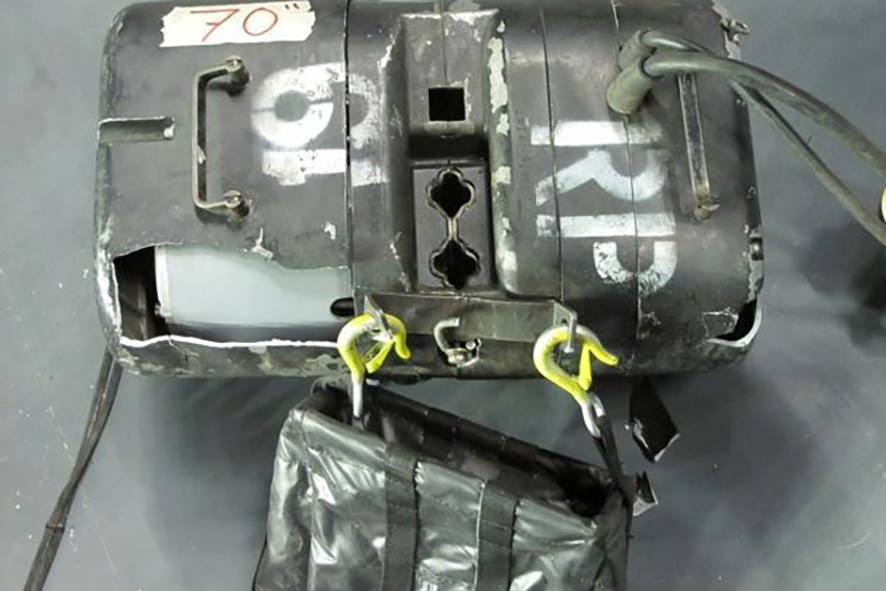
BS 7905-1:2001
8.4.5 Powered chain hoist
c) Where fitted, chain collecting bags or buckets of sufficient size shall be designed and constructed and securely fitted to the hoist to prevent hazards caused by slack load chain hanging from the hoist.
BS 7906-1:2005
8.19.2 Selection and ordering
Whether chain bag or box and required capacity. The chain should fill a maximum of 50% of the bag/box when the hook is fully retracted. There should be no possibility of the chain being able to spill out of the container because of inadequate capacity.
8.19.5 Operation and use
The chain bag should be securely attached, compatible with the hoist and correctly positioned so that chain runs naturally into the bag.
[…]
During operation and use of chain hoists the following precautions should be taken:
Ensure chain bag/boxes are correctly fitted and have sufficient capacity for the volume of chain.
[…]
Where hoists are rigged out of view, for example above a grid or in a rood void, regular checks should be made of the integrity and stability of chain bags and to ensure that chains are running correctly into them.
Let’s summarise what the above technical publications are prescribing:
— The load chain should run easily inside the chain bag
— The chain bag should be large enough to securely hold the entire chain
— The chain bag should be filled for the 50% of its capacity
— The chain should not spill outside the bag.
— It should be securely attached.
— The last link of the load chain should be fixed to the hoist’s body.
Some have questioned that such recommendations are not sufficient for a chain bag to claim fitness for purpose, and Blumano may agree with it.
Recommended technical specifications
“the devil makes the pots, but not the lids”.
Chain hoist manufactures produce superb chain hoists, however when it comes to chain bags, they normally outsource the design and manufacturing of them, generally because the knowledge and expertise required to produce a textile chain bag is — legitimately —outside their range of competence.
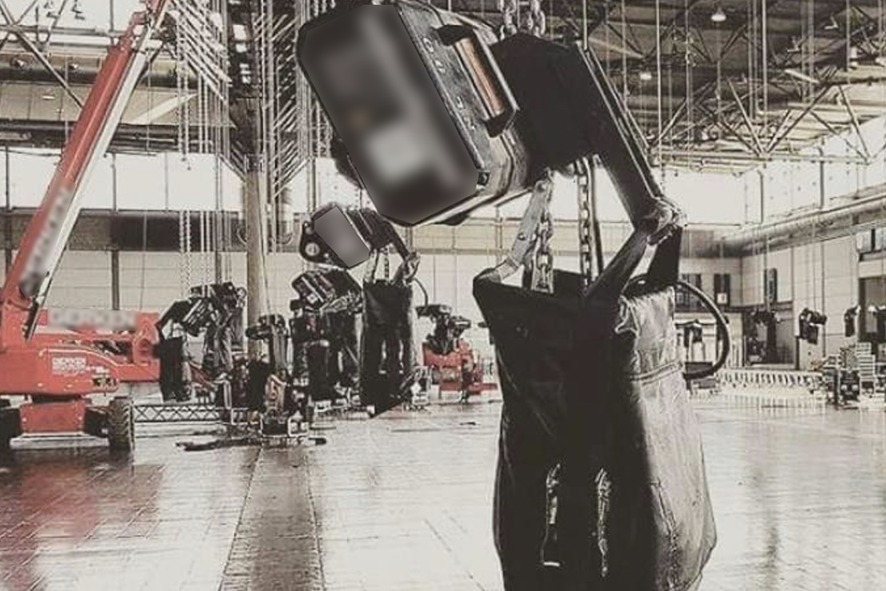
In absence of specific guidelines from standards and regulations, a chain bag design is left to the expertise and common sense of the accessory manufacturer.
From an engineering point of view, we believe there are some fundamental factors that should not be ignored when designing and manufacturing a chain bag:
WLL
A chain bag filled with 28 meters of 7.9mm chain may weight 40 kg, the equivalent of two bags of cement suspended above people inside a textile container.
A chain bag manufacturer should — from our point of view shall — declare the working load limit of the chain bag, the maximum admissible load that the chain bag can hold, and prove that all the elements from the attachment point to the lower part of the bag are designed to keep such load suspended with adequate margin of safety.
Ultimately, a chain bag is a device used to keep suspended loads above people’s head, and users must know the working load limit of such product.
Capacity
Chain bags are often designed to be integrated with different brands and models of chain hoists and the recommended load chain capacity should be declared — a product label applied to the bag should be sufficient — in order to guide and inform the user.
The three requirements in the standards concerning the adequate size of the chain bag (1 – the chain bag should be large enough to securely hold the entire chain; 2 – the chain bag should be filled for the 50% of its capacity; 3 – the chain should not spill outside the bag) cannot be followed by the user unless the chain bag manufacturer declares the permissible capacity per type of chain.
The fitness for purpose of a chain bag is very much related to its intrinsic ability to be properly integrated with the correct chain hoist.
It is highly recommended to mark or label a chain bag with the type of load chain and the length of load chain in relation to the % of the capacity of the bag.
Interchangeability
When assessing the risk related to a chain bag design, the manufacturer should also consider the foreseeable human behaviour: chain bags used in the event industry are regularly interchanged between chain hoists in order to fit different kind of chain lengths.
For various reasons, it is common practice for owners of chain hoists to regularly replace or substitute load chains, and consequently allocate to a chain hoist a chain bag with the correct storage capacity.
When selecting a suitable chain bag attachment hardware, a chain bag manufacturer should take under consideration this aspect and ideally provide to the user an attachment method (snap hooks, quick links, carabiners, etc.) suitable to be integrated with a large variety of models, if the chain bag design allows it.
Some chain bags are specifically designed for a particular hoist brand/model, therefore may not present such option, in which case this should be made clear to the user.
Ability to be securely attached/detached
As part of its normal use, a chain bag used in the event industry needs to be easily attached and detached from the chain hoist, to facilitate the transportation, assembly, commissioning and dismantling operations.
Chain bags full of chain can be very heavy, way above the weight an employee is allowed to manually handle; also, during chain hoist transportation load chains are often removed from the bag and stored in specific compartments of the flight case.
When riggers suspend a chain hoist to a mother grid, they normally detach the chain bag from the chain hoist and only after the chain hoist is installed, the chain bag is attached to the hoist.
Chain bag attachment means (snap hooks, quick links, carabiners, etc.) should be selected to facilitate the attachments/detachment operation but they also need to provide a secure attachment method (hooks without latch, C or S open links, other sliding lose-attachment means may not be sufficient to provide a secure attachment)
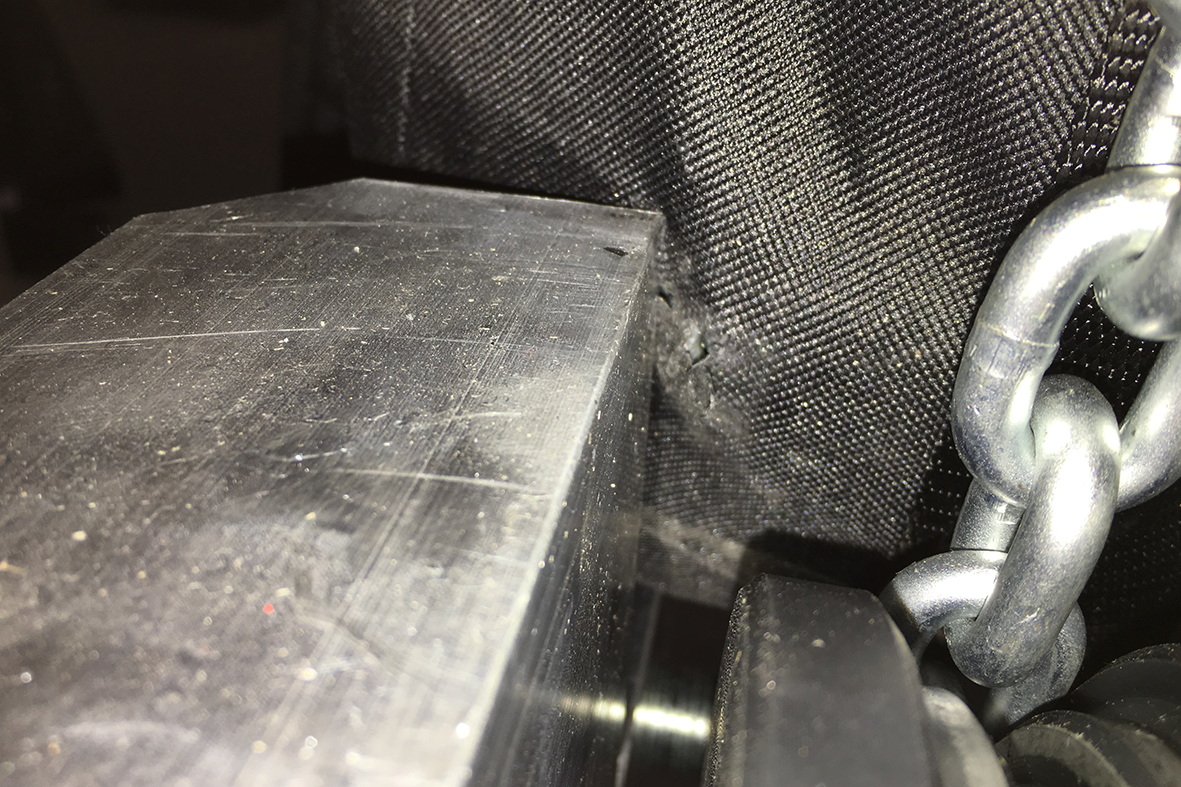
Resistant and durable
The biblical King Nebuchadnezzar’s Dream describes a Statue with the head made of pure gold, its chest and arms of silver, its belly and thighs of bronze, its legs of iron, its feet partly of iron and partly of baked clay.
The most important — and often forgotten — requirement of a chain bag is that the fabric, belts and stitching must be robust, designed to withstand the forces they are subject to and to be resistant to accidental drops and contact with angular parts or sharp edges.
In a textile chain bag, the selections of the appropriate fabric and the way the chain bag is manufactured and stitched has a massive relevance in respect to its reliability.
Materials with unknown elongation values or insufficient resistance to laceration may not be suitable to be used to manufacture a chain bag and pose serious concerns in relation to a chain bag fitness for purpose.
When chain bags are fitted with belts — and the belt is the primary mean to hold the load chain weight — such belts should distribute the load to the bag suspension points rather than letting the fabric stitching support the majority of the chain weight.
Cheap chain bags are often manufactured with materials and techniques not suitable to withstand the forces a chain bag is subjected to and often they are manufactured with stitching methods4 that breaks the fabric fibres, reducing even more the strength of the bag as such.
The statue clay feet.
Conclusions
Chain bag systems are simple products, the technology behind its design and manufacturing can be very simple since the ingredients are known and easy to be sourced.
However, the designs of chain bags live in a compliance and legislation limbo in which there are no fully comprehensive guidelines and recommendations to guide the designers.
Nevertheless, the technical community (riggers, installers, technicians and owners of chain hoists) do agree that there is a huge gap between professional chain bags and cheap Asian import products.
A chain bag should be made with durable and resistant materials, with the ability to be securely attached and detached, with clear marked WLL and Chain capacity, large enough to securely hold the entire chain, designed so that the chain will easily run into it without spilling out, ideally used at 50% of its capacity.
Think about it.
References
1. The Guardian – 2016 – Adele fan injured by falling chain at Glasgow concert. https://www.theguardian.com/music/2016/mar/26/adele-fan-injured-falling-chain-glasgow-concert
2. Machinery Directive 2006/42/EC – Article 2 – (b) ‘interchangeable equipment’ means a device which, after the putting into service of machinery or of a tractor, is assembled with that machinery or tractor by the operator himself in order to change its function or attribute a new function, in so far as this equipment is not a tool.
3. Machinery Directive 2006/42/EC – Article 2 – (c) ‘safety component’ means a component: which serves to fulfil a safety function, which is independently placed on the market, the failure and/or malfunction of which endangers the safety of persons, and which is not necessary in order for the machinery to function, or for which normal components may be substituted in order for the machinery to function.
4. Regular point needles create a small hole in the fabric as is sews, although they allow a fast sewing process.
Rounded tip needles instead, allows the needle to pass between the fabric threads by separating them, but they become hot faster and the sewing process is slower.
